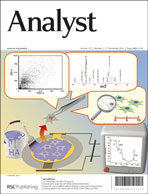Development of amperometric lysine biosensors based on Au nanoparticles/multiwalled carbon nanotubes/polymers modified Au electrodes†
Abstract
The construction of two amperometric L-lysine biosensors is described in this study. The construction comprises the covalent immobilization of lysine oxidase (LOx) onto nanocomposite composed of gold nanoparticles (AuNPs) and carboxylated multiwalled carbon nanotubes (c-MWCNT), decorated on (i) polyaniline (PANI) and (ii) poly 1,2 diaminobenzene (DAB), electrodeposited on Au electrodes. The biosensors were characterized by scanning electron microscopy (SEM), Fourier transform infrared (FTIR) and electrochemical impedance spectroscopy (EIS) studies. The optimum response (current) was observed within 2 s at pH 7.0 and 25 °C for LOx/AuNPs/c-MWCNT/PANI/Au, and 4 s at pH 7.0 and 30 °C for LOx/AuNPs/c-MWCNT/DAB/Au electrodes. There was a linear relationship between current and lysine concentration ranging from 5.0 to 600 μM for LOx/AuNPs/c-MWCNT/PANI/Au with a detection limit of 5.0 μM, and 20 to 600 μM for the LOx/AuNPs/c-MWCNT/DAB/Au electrode with a detection limit of 20 μM. The PANI modified electrode was in good agreement with the standard HPLC method, with a better correlation (r = 0.992) compared to the DAB modified electrode (r = 0.986). These observations revealed that the PANI modified Au electrode was better than the DAB modified electrode, and hence it was employed for the determination of lysine in milk, pharmaceutical tablets and sera. The PANI modified electrode showed a half life of 120 days, compared to that of 90 days for the DAB modified electrode, after their 100 uses, when stored at 4 °C.


 Please wait while we load your content...
Please wait while we load your content...